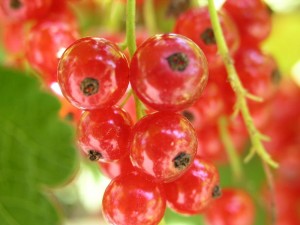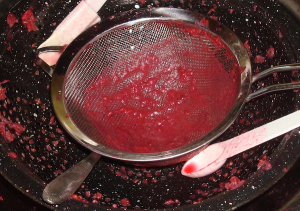
Cooking is chemistry writ large. You start by learning how to measure volumes, mass and ratios, but end up talking about polymers and stoichiometry. It can get very complicated, but it’s easy enough that anyone can do it, going into different depths.
I’m planning on jam making this fall and in testing a recipe I became curious about if I could do it without adding store-bought pectin. Red currants should have enough pectin but the question of extracting it came up.
I was curious to see if I actually get more pectin from the liquid squeezed last through the handkerchief (with much wringing) than I get from the pulp and juice of the red currants I initially squeezed through a coarse strainer. So, I tested the two batches of liquid for pectin. A simple application of science in cooking.
Date: 12/29/09.
Hypothesis: The juice (the filtrate) squeezed out of the currants through the strainer will have less pectin than the juice strained out of the seed and skin leftover of the straining (the retentate) because I think I remember reading somewhere (always dangerous) that pectin can be found in or just beneath the surface of the skin of fruits.
Procedure: Using the test from the University of Minnesota extension service: Add 1 teaspoon of juice to 1 tablespoon of rubbing alcohol and observe how well it coagulates after 2 minutes. This test is performed in two small shot glasses.
Observations: It is difficult to quantify how firm are the gels that forms at the bottom of the shot glasses. Although I could construct a simple device to test gels resistance for force, I opt to assess the gels by swirling the glasses and observing how they move. Eyeballing the results, it seems that the first extraction of pulp and juice has more pectin. An independent observer agrees with this observation.
Conclusion: My initial hypothesis is wrong. Based on this experiment I now hypothesize that the pulp of the currants has more pectin. Five minutes of internet searching seems to confirm this new hypothesis, and suggests that my initial belief that pectin can be found under the skin of fruits comes from the fact that this is true for citrus fruits.
